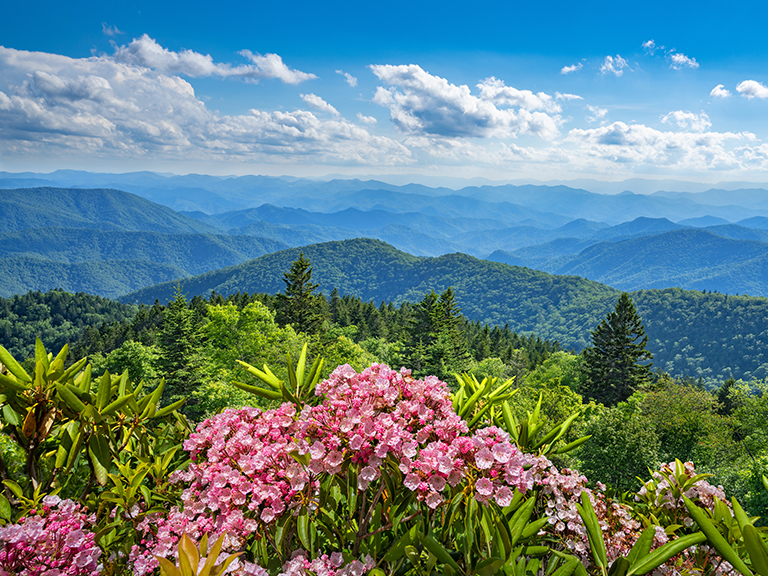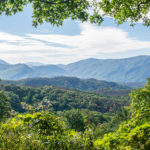When is the best time of year to visit the Smokies? The answer to this question depends on what you’re coming here to see. Do you want to hike the Smoky Mountains while the trees are green and the sun is shining? You should visit during the summer. Do you want to see the leaves change on the trees? Make your visit in the fall. Do you want to experience the beauty of icicles and rolling hills and feel the chill of crisp mountain air? Winter is the right season for you.
But if you’re looking to the visit the Smoky Mountains when the wildflowers are in bloom—when an array of trilliums grace the forest floor, when wild geraniums share their bright pinks and purples, when azaleas and bleeding hearts and crested dwarf irises are in full bloom—you’ll need to make your travel plans for spring! Beginning in March, the Great Smoky Mountains National Park is home to more than 1,500 kinds of flowering plants—more than you’ll see in any other U.S. national park.
The wide variety of wildflowers and flowering shrubs in the Great Smoky Mountains has drawn the attention of thousands of guests for decades. In fact, the annual event that celebrates these beautiful flowers—the Spring Wildflower PIlgrimage in the Smokies—is in its 66th year this year, hosting its five-day event from April 19–23, 2016. At the Spring Wildflower Pilgrimage, you can join hundreds of other visitors as they participate in outdoor walks and tours as well as indoor seminars—all in an effort to learn about and celebrate the flowers, wildlife, culture, and natural history of the Smokies.
Although we definitely recommend that you join the Spring Wildflower Pilgrimage at least once, don’t worry if those dates don’t work for you in 2016. You don’t have to participate in a special event to see and appreciate the natural beauty of Smoky Mountain wildflowers. Actually, one of the easiest ways to do this is with a wildflower walk. The Great Smoky Mountains National Park is filled with hundreds of miles of hiking trails that range from easy to moderate to challenging.
During the spring, some of the hikes in the national park are better than others to see the blooming wildflowers. We’ll list a few of those hikes below. Most of these hikes are easy to moderate, making them accessible for even novice hikers. You can try one or try them all when you’re in town this spring. Be sure to wear your hiking boots, take lots of water, and, of course, bring your camera so you can capture the beauty of springtime in the Smokies for yourself!
Cove Hardwood Nature Trail
This trail is a short ¾-mile loop that offers some of the best spring wildflower viewing in the national park. You’ll also get to walk through old-growth forests, and there’s a picnic area you can use for a quick lunch before or after your hike. The trail begins inside the Chimneys Picnic Area; look for the parking lot on the right after entering this area, and you’ll find the trailhead above the parking lot.
Deep Creek Trail
Another easy trail, you’ll find this wildflower walk at the end of Deep Creek Road—a half-mile beyond the Deep Creek Campground turnoff. If you walk about 2 miles roundtrip, you’ll have the chance to see 2 waterfalls (Indian Creek and Toms Branch) as well as a variety of wildflowers (crested dwarf iris, Solomon’s seal, bluets, and more). If you want to keep hiking, the trail continues as a 4.6-mile loop. Keep in mind the trail does get steeper after the Deep Creek Loop Trail junction, climbing roughly 350 feet, but at this elevation you’ll get to see mountain laurel, rhododendron, and flame azalea when they’re in bloom.
Little River Trail
The trailhead for this hike can be found on a side road just before you enter Elkmont Campground. If you hike the first 2 miles, you’ll get to view a variety of wildflowers from mid-March through April. You can also add Cucumber Gap and Jakes Creek trails, making this a moderate 5.1-mile loop hike. The trail is relatively wide and level and follows the scenic Little River as it flows toward its headwaters. On this trail, expect to see spring beauties, trailing arbutus, hepaticas, yellow trillium, stonecrops, Canadian violets, and more.
Middle Prong Trail
For wildflowers and waterfalls, head to the trail that starts at the end of Tremont Road, which is just west of the Townsend “Y.” This trail offers a variety of flowers, including foamflower, toothwort, violets, wood sorrel, and trilliums. You’ll also get to view 3 major waterfalls, many smaller falls, cataracts, and cascades. The entire trail is 8.3 miles roundtrip, but you can view most of the wildflowers on this trail in the first 2 miles.


